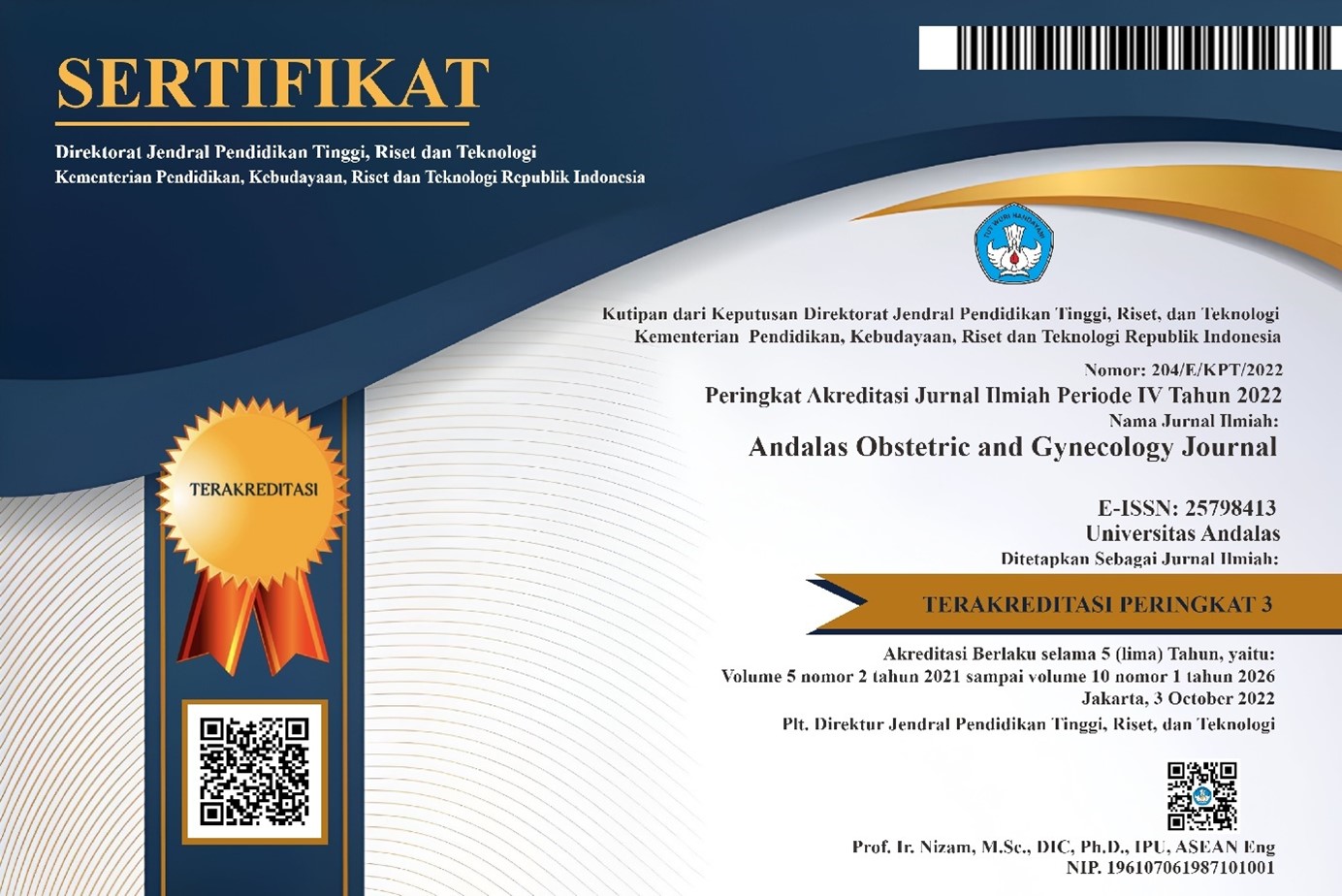ROMA and IOTA Score Comparison in Predicting Ovarian Tumour Malignancy
DOI:
https://doi.org/10.25077/aoj.4.1.70-76.2020Abstract
Ovarian cancer is the sixth most common cancer found among women. Incidence of ovarian cancer in Dr. M. Djamil Central Hospital had increased from 103 cases to 156 cases in 2011-2012. The Risk Of Ovarian Malignancy Algorithm (ROMA) consists of qualitative serum test where several variables including HE4 serum, CA125 serum, and menopausal status are turned into numerical score (Hye Yon Cho et al 2015). The latest diagnostic modalities developed by International Ovarian Tumour Analysis (IOTA) classifies tumour into four sub groups, based on ultrasound characteristics: unilocular, multilocular, adnexal mass with solid component without papilloma projection, adnexal mass with one or more papilloma projection. Based on this knowledge, author would like to investigate accuracy of ROMA and IOTA score in predicting malignancy status of early ovarian tumour.
Objective: Determining ROMA and IOTA so thus can be utilised to predict wether the ovarian tumour is benign or malignant.
Method: This was analytical study, with cross sectional design and took place in Obstetrical and Gynaecological Outpatient Clinic of Dr. M. Djamil Central Hospital from August 2016 to January 2019. Sample was recruited using consecutive sampling method. Sixty one participants were recruited with CI 99%. Patients who met inclusion criteria would undergo Ca125 serum test and IOTA score. HE4 level was determined after surgery and the sample of a tumour was sent to pathology anatomy laboratory of Medical Faculty of Andalas University to investigate the malignancy status. Statistical analysis involved univariate and bivariate test. The variables included frequency distribution, ROMA, and IOTA score. Bivariate analysis included specificity, sensitivity, positive predictive value, negative predictive value, positive likelihood ratio, negative likelihood ratio.
Result: Thirty one patients (50,8%) from peri menopausal group had HE4 level ≤70 pmol/L and 30 patients (49,2%) from post menopause group had HE4 level ≤140 pmol/L. Eleven patients (18%) had CA125 level <35 and 50 patients (82%) had CA125 level ≥35. ROMA index showed low risk in 17 patients (27,9%) and high risk 44 patients (72,1%). IOTA with M Rules was 51 patients (83,6%) and B rules was 10 patients (16,4%). Diagnostic value for ROMA score had sensitivity of 71,9%; RMI of 84,2%; and IOTA 82,5%. ROMA and IOTA accuracy was 68,9% and 92,2%, respectively.
Conclusion: IOTA has better sensitivity in predicting ovarian tumour compared with ROMA. ROMA has higher positive predictive value compared with IOTA positive predictive value. ROMA negative predictive value is 5,9%, meanwhile for IOTA it is hard to determine
Keywords: ovarian cancer, ROMA, IOTA, Ca-125, HE4References
Chan DW, et al. Use of Tumor Markers in Testicular, Prostate,Colorectal, Breast, and Ovarian Cancers. Washington, United State: the American Association for Clinical Chemistry, Inc. 2009
Anton C, et al. A comparison of CA125, HE4, risk ovarian malignancy algorithm (ROMA), and risk malignancy index (RMI) for the classification of ovarian masses. Sao Paolo: CLINICAL SCIENCE, 2012. 437-41.
Bianca Ortiz, et al. HE4, Ca125, and ROMA Algorithm for Differntial Diagnosis Between Benign Gynaecological Diseases and Ovarian Cancer.2014.
Yamamoto Y, et al. Comparison of 4 Risk-of-Malignancy Indexes in the Preoperative Evaluation of Patients With Pelvic Masses. Clinical Ovarian and Other Gynecologic Cancer , 2014. 8-12.
Daniel W. Chan, José Carlos Campos Torres, et al. Risk-of-Malignancy Index in preoperative evaluation of clinically restricted ovarian cancer. São Paulo Medical Journal. 2009. p; 73-5
Hye Yon Cho et al. Comparison of HE4 ,CA125 and Risk Of Ovarian Malignancy Alogarithm in the Prediction of Ovarian Cancer in Korean Woman. 2015
Fujirebio Diagnostics AB. ROMA, HE4 EIA + ARCHITECT CA 125 IIâ„¢.; 2011.
Budiana, I. N. TUMOR OVARIUM: PREDIKSI KEGANASAN PRABEDAH. JURNAL ILMIAH KEDOKTERAN, 44 (DivisiOnkologi-Ginekologi, Departemen Obstetri dan Ginekologi FK Unud/RSUP Sanglah Denpasar).2013.179-85.
Sussane J. IOTA Terminology,Simpel Descriptor and Simpel Rules T Van Gorp, et al. HE4 and CA125 as a diagnostic test in ovarian cancer: prospective validation of the Risk of Ovarian Malignancy Algorithm. British Journal of Cancer 2016. p;1-8.
Vinicius P, et al. The Contribution and Prespective of Proteomics to uncover ovarian cancer tumor marker. 2018.
Yurkovetsky Z, et al. Development of a Multimaker Assay for Early Detection of Ovarian Cancer. Journal of Clinical Oncology The University of Pittsburgh. 2010; 2159-166
Downloads
Published
Issue
Section
License
Copyright (c) 2020 JOURNAL OBGIN EMAS

This work is licensed under a Creative Commons Attribution 4.0 International License.
Copyright
Authors who publish with this journal agree to the following terms:
- Authors retain the copyright of published articles and grant the journal right of first publication with the work simultaneously licensed under a Creative Commons Attribution 4.0 International License that allows others to share the work with an acknowledgment of the work's authorship and initial publication in this journal.
- Authors are able to enter into separate, additional contractual arrangements for the non-exclusive distribution of the journal's published version of the work (e.g., post it to an institutional repository or publish it in a book), with an acknowledgment of its initial publication in this journal.
- Authors are permitted and encouraged to post their work online (e.g., in institutional repositories or on their website) prior to and during the submission process, as it can lead to productive exchanges, as well as earlier and greater citation of published work (See The Effect of Open Access).
License:
Andalas Obstetrics and Gynecology Journal (AOJ) is published under the terms of the Creative Commons Attribution 4.0 International License. This license permits anyone to copy and redistribute this material in any form or format, compose, modify, and make derivatives of this material for any purpose, including commercial purposes, as long as they credit the author for the original work.







